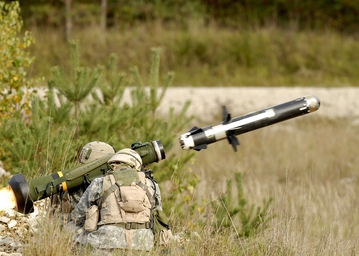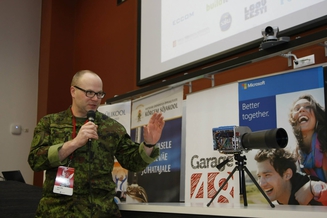Lieutenant Colonel Sten Allik together with his team at the Estonian National Defence College is participating for the 2nd time at the Garage48 Hardware & Arts 2016 hackathon in Tartu. Last year they managed to bring home the winner title with their prototype of an shooting error correction device and mobile app called Hitafly. This made us curious regarding what other innovations are used in the military and how has the hackathon inspired their use of modern technology since then.
1. This is the second time for you to participate in the hackathon. Are you going to present some new ideas as well?
Personally, probably not this time. I want to take an opportunity to have some insight in all teams. Being a team-member you may not have this possibility. But for sure there will be a number of military ideas, and I’ll give my input in them.
2. The Estonian National Defence College participated also in the Garage48 Hardware & Arts 2015 hackathon last year. One of the ideas, of the many fascinating ideas that the academy presented, also managed to win the hackathon. Could you tell us a little bit, how the winner Hitafly is doing and what is next on their agenda?
Meanwhile the team has continued the work on the device by approving its reliability and functional preciseness. I’m very happy that the team has been kept together to continue the development and hopefully this year they can come up with a new prototype. I’d also like to highlight the fact that the team members of the Estonian Defence Forces are active members of the team and continue to provide their specific know-how.
3. The Estonian National Defence College is now also co-operating with the architectural students of the Estonian Academy of Arts to redesign the defence campus in Tapa. What is the mission of this project?
Military bases are like small towns or municipalities. The Tapa military base is the home base for most of the units of 1st Infantry Brigade, the number of people living and working every day on the base is close to one thousand people. The base itself comprises new and mordern buildings, as well as older ones, which are originally from pre-World War II time or a heritage of Soviet troops. That makes it socially and architecturally a special environment. This environment has to be as suitable as possible for daily service, that means for training of new soldiers. At the same time, it has to be also supportive for soldiers to keep up their mental and physical fitness. The idea was to provide this specific environment with its specific requirements as a playground for the students of the Academy of Arts to see what kind of ideas they can come up with to ameliorate the baseas a whole and more precisely the environement inside its caserns. The reachback what I have recieved from the academy as well as from the brigade commander is very positive and I’m convinced that the cooperation will continue in the future.
4. Innovation and technical forward-thinking definitely play an essential role in the military. Could you say what are some of the most exciting technologies that are being used by the Estonian military today?
Some recent acquisitions are for example the anti-tank missile Javelin or combat vehicle CV-90 are top level technological solutions. The technical development in the military world goes at high speed and as with every new solution, the adversary wants to find a counter-capability. For me the most exciting technologies are the ones under development in Estonia, for example and among number of ones, in the domains of force protection and situational awarness. But let’s hear about these developments once it is the right time for that.
5. Could you also give us some examples of some very top-notch technologies the military is using throughout the world?
One of the recent „wow!“-emotion I had when I saw a video about mini-UAV-swarm, which is self-organising. It’s fascinating to imagine, what kind of implications that kind of solutions can bring into the battlefield. It’s not in use yet but I suppose that this kind of new solutions do impact already our understanding of future warfare.
6. What are some of your own personal favourite apps that you are using every day?
Frankly I do not use often apps in my daily life. I’m not an appiphile nor appiphobe. It’s not that I have something against them, but probably the nature of my work – managing the defence R&D – needs the applications which are in my own brain – finding new ways to resolve challenges. It’s just thinking.
7. As the whole world is seeing a horrible time of hazardousness and vulnerability. Could technology actually do something to give people a sense of security and readiness?
The time what we are living has signs which do not indicate very positive developments. But we should also keep in mind that technology gives possibilities to shape the field of information we use daily, the information based on what we evaluate our level of security. And it is sometimes very demanding to make difference between objective information and manipulation.
The sense of vulnerability is based on the understanding of primary and secondary requirements for feeling safe. Technologies for sure provide tools which help us to predict threats or manage dangerous situations. Today’s possibilities what technology provides for information exchange, building up situational awareness, handling complex situations, protecting people etc. can increase the sense of security, as well as real security – these are two different things. But it can also initiate kind of false sense of security when people start to rely on technology too much, when they think that technology per se resolves the problem of threats. Technology can thus also increase vulnerability. Take for example today’s dependency on technology. On the battlefield we try to be as self-sustainable as possible by taking into account possibilities „what if?“ also in the field of technology. But what about our daily life, do we think about it?
8. What is the best advice you have ever received?
Nowadays we tend to speak often about new solutions – to use them, to develop them etc. Frequently the problem is that we have not identified the root of the problem what we want to aim with a new solution. We think that a new solution is always something that resolves the problem automatically, whatever the problem is. That’s why I think the sentence „In order to find the solution you have to know, what the problem is“ or its paraphrase „Every solution is good if you do not know what the problem is“ is the advice I recall myself often.
9. What are you most looking forward to at the Garage48 Hardware & Arts 2016 hackathon?
For sure new fascinating ideas and solutions. But also, and not less important for me, the energy that is created when passionate persons work together to achieve a challenging end-state in a very short time. It’s inspiring. And finally – it’s still a game in its best, and a game means fantasy. Even if it’s a serious game, a good portion of fun should be part of it. So let the mind fly!


